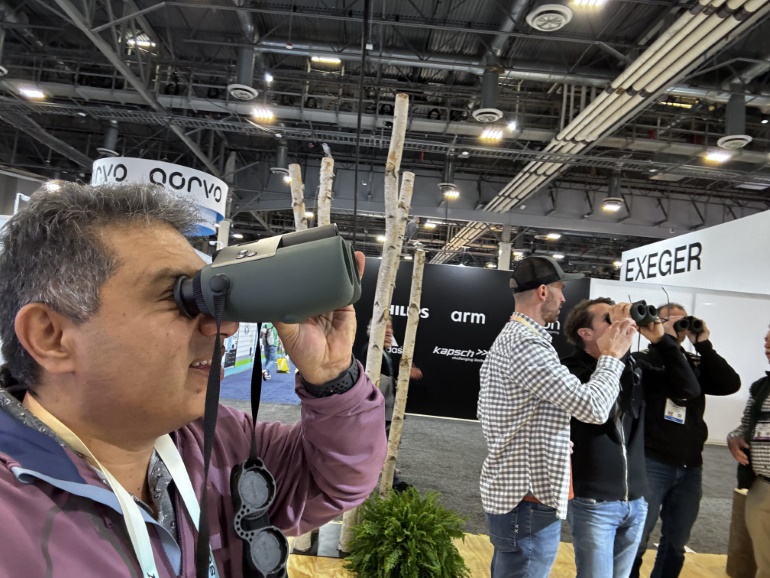
Although I cover primarily corporate technology, sports technology has always interested me. At the recent CES consumer electronics show that I attended, I was looking for interesting tech that can change how people play and compete.
Here are my top five picks with one bonus failure.
Livall Smart Cycling Helmet
The bike helmet is a piece of equipment that hasn’t evolved much in my years of cycling. I’m sure they’re made with better material and are lighter, but there’s rarely any tech built into them.
At the show, I stopped by Livall, who now makes the first “Smart and Safe” cycling helmet. The helmet is outfitted with some cool tech, such as brake warning lights that automatically come on when the helmet senses a decrease in speed, automatic fall detection, one-button S.O.S., and smart lighting.
There are JBL speakers mounted in the helmet, obviating the need for headphones, which can cause the cyclist not to hear traffic. There is also a push to talk walkie-talkie to communicate with other cyclists. The helmet retails for $129 USD, which is less expensive than most cycling helmets.
Swarovski Optik AX Visio AI Binoculars
This is part of a broader line of visual gear from Swarovski that includes rifle and spotting scopes and thermal imaging. Although these binoculars (pictured), may look like ordinary ones, they are anything but. These are high-powered binoculars, 10×32 magnification with a 1,000-yard field of view.
In addition, with the simple click of a button, the glasses can identify more than 9,000 birds and mammals with its unique AI imaging feature. There is also a 13-megapixel, 1080p video camera with wireless transfer to a companion application, making social sharing easy. The camera has a price tag of $4,799, which may seem hefty but might be worthwhile for serious birders.
Holoswim Smart Swim Goggles 2s
Swimmers don’t have the luxury of being able to look at a phone or other tracking device in the water. Even flipping one’s wrists down to check out a watch could break the rhythm of the stroke.
The Holoswim Goggles have a real-time, near-eye display so the swimmer will see data projected onto the lens. This includes stroke count, swimming distance and pace, laps and other performance data. The goggles are smart enough to track a wide range of strokes, including freestyle, butterfly and backstroke, and retail for $199. The Hangzhou Guangli Technology company, which owns the brand, also plans to release similar eyewear for cycling, running and skiing.
Mojawa HaptiFit Terra IP68 Headphones
This is one of many bone-conduction headphones available today. For those unfamiliar with bone conduction, the speaker can be placed outside the ear, allowing the wearer to hear other noises, such as traffic or other people.
Bone conduction is where the comparison stops, as these headphones are loaded with training features such as real-time health monitoring and activity tracking. A mobile application also shows distance, duration, pace, calories burned and other data. I currently use the Shokz (formerly Aftershokz) OpenRun Pro headphones, and there is a marked difference in sound quality. The Mojawa headphones have much deeper bass and overall better sound quality.
Also, Mojawa demonstrated its headphones working in a water tank. With Shokz, I rode in a heavy rainstorm with them, and they stopped working. Price for the HaptiFit headphones is $299.
Phigolf Golf Simulator
If you’re someone who has wanted to put a golf simulator in your home but can’t afford the big price tag of a Trackman, Phigolf has a solution. Unlike most simulators, which require about 10 to 12 feet of clearance to get a driver over your head, Phigolf can be used in a normal room.
The simulator works with a shortened, weighted shaft with a sensor in the butt end. The display can be as small as a mobile phone or projected onto a wall for a more immersive experience. When I first tried it, I was skeptical that it would measure correctly, but I took several swings with different “clubs,” and the measurements were close to my actual yardage.
One of the benefits of Phigolf is that the sensor can be removed from the shaft and put into a regular golf club, creating some flexibility. You certainly don’t get the feedback of brushing your club on the grass or the frustration of chunking one down the fairway, but it’s about as good an in-room simulator as I have seen. The price for the Phigolf kit is $249.
Worst sports tech at CES 2024: FIDA Drone Soccer
Maybe I’m a curmudgeon, but when I think of sports technology, it’s some kind of mix of sports and tech. At CES, the Federation of International Dronesoccer Association, or FIDA, demonstrated drone soccer. The “match” is played in a big cage, with people in an end zone controlling drones inside a plastic ball.
Those balls are moved through the air, and the pilot tries to get them through a ring at the far end, which is the goal. If you like flying drones in a cage, this might be for you, but it hardly falls under my definition of sports tech. You can watch a YouTube video of it here.